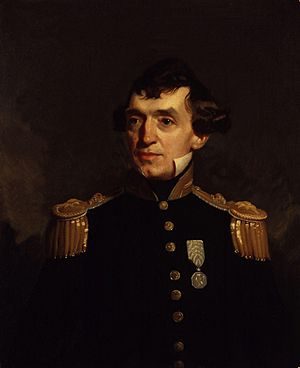Robert McCormick (explorer) facts for kids
Quick facts for kids
Robert McCormick
|
|
|---|---|

Robert McCormick, by Stephen Pearce.
|
|
| Born | 22 July 1800 Great Yarmouth, England
|
| Died | 25 October 1890 (aged 90) |
| Nationality | British |
| Occupation | surgeon |
Robert McCormick (born July 22, 1800 – died October 25, 1890) was a British Royal Navy ship's surgeon. He was also a famous explorer and a naturalist. This means he studied nature and went on many exciting trips around the world.
Contents
Who Was Robert McCormick?
Robert McCormick was born in Great Yarmouth, England. His father, also named Robert McCormick, was a ship's surgeon too. Young Robert decided to follow in his father's footsteps.
In 1821, Robert McCormick began studying medicine in London. He learned at two famous hospitals: St Thomas' Hospital and Guy's Hospital. By 1822, he had earned his medical diploma.
In 1823, he joined the Royal Navy as an assistant surgeon. His first assignment was in the West Indies. He served there for two years. After that, he worked on a ship in the North Sea.
Exploring the Arctic
In 1827, McCormick became an assistant surgeon on the ship Hecla. This ship was part of an expedition led by William Edward Parry. Their goal was to find the North Pole. This was a very challenging and cold journey!
McCormick and the HMS Beagle
After his Arctic adventure, McCormick took a break from the Navy. He went to the University of Edinburgh in Scotland. There, he studied natural history with a famous teacher named Robert Jameson. The Navy actually encouraged this, as they wanted their surgeons to know about nature.
Joining the Beagle Expedition
In 1831, McCormick returned to London. He was chosen to be the ship's surgeon for the second voyage of HMS Beagle. This was a very important survey expedition to South America. McCormick thought this job would let him do a lot of natural history research. He hoped to collect many specimens and become famous.
Meeting Charles Darwin
Before the Beagle set sail, McCormick met Charles Darwin. Darwin was also going on the voyage as a naturalist. He paid his own way and was a companion to Captain Robert FitzRoy.
Darwin wrote about McCormick, saying he was a bit silly but they got along. He mentioned that McCormick worried a lot about the color of his cabin!
A Disappointing Voyage
The Beagle voyage began. Their first stop was in the Cape Verde Islands in January 1832. McCormick and Darwin explored the land together. However, McCormick found it hard to collect things.
Captain FitzRoy often took Darwin ashore, leaving McCormick behind. This made McCormick very frustrated. The final straw came in April 1832, in Rio de Janeiro. FitzRoy arranged for Darwin's collections to be sent back to England. McCormick felt he wasn't getting the chance to do his own natural history work.
Because of this, McCormick decided to leave the Beagle. He got permission to go home on another ship, HMS Tyne.
Later Expeditions and Achievements
After the Beagle, McCormick continued his career.
Antarctic Exploration
From 1839 to 1842, McCormick was a surgeon on James Clark Ross's expedition to the Antarctic. On this trip, another naturalist, Joseph Dalton Hooker, did most of the nature studies. McCormick focused on geology (studying rocks and the Earth) and collecting birds. He was helped by Thomas Abernethy.
Royal College of Surgeons
In 1844, Robert McCormick became a Fellow of the Royal College of Surgeons. This was a great honor for a surgeon.
Search for John Franklin
McCormick also led a search party to find John Franklin. Franklin was another famous explorer who went missing in the Arctic. McCormick's search was not successful.
His Autobiography
In 1884, McCormick wrote a book about his life. It was called Voyages of Discovery in the Arctic and Antarctic Seas and around the World. This book shared his many adventures.
McCormick's Legacy
Robert McCormick left his mark on the world in several ways.
Animals Named After Him
The south polar skua (Stercorarius maccormicki) is a type of bird named after him. A scientist named Howard Saunders gave it this name. McCormick himself shot the first known example of this bird in Antarctica in 1841.
Places Named in His Honor
Several places are named after Robert McCormick:
- Devon Island's Macormick Bay in Canada. This area is near where he searched for Franklin.
- MacCormick Fjord in northwest Greenland. This fjord was named by explorer Robert Peary.
Images for kids


